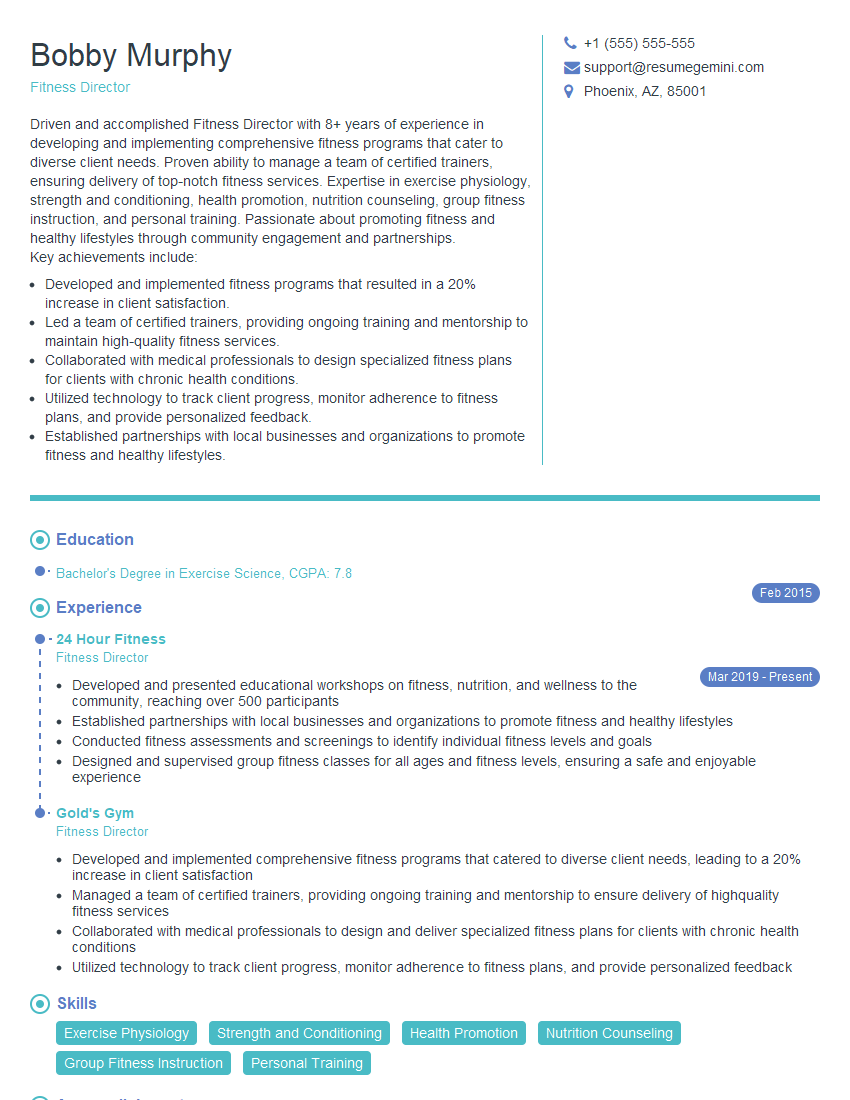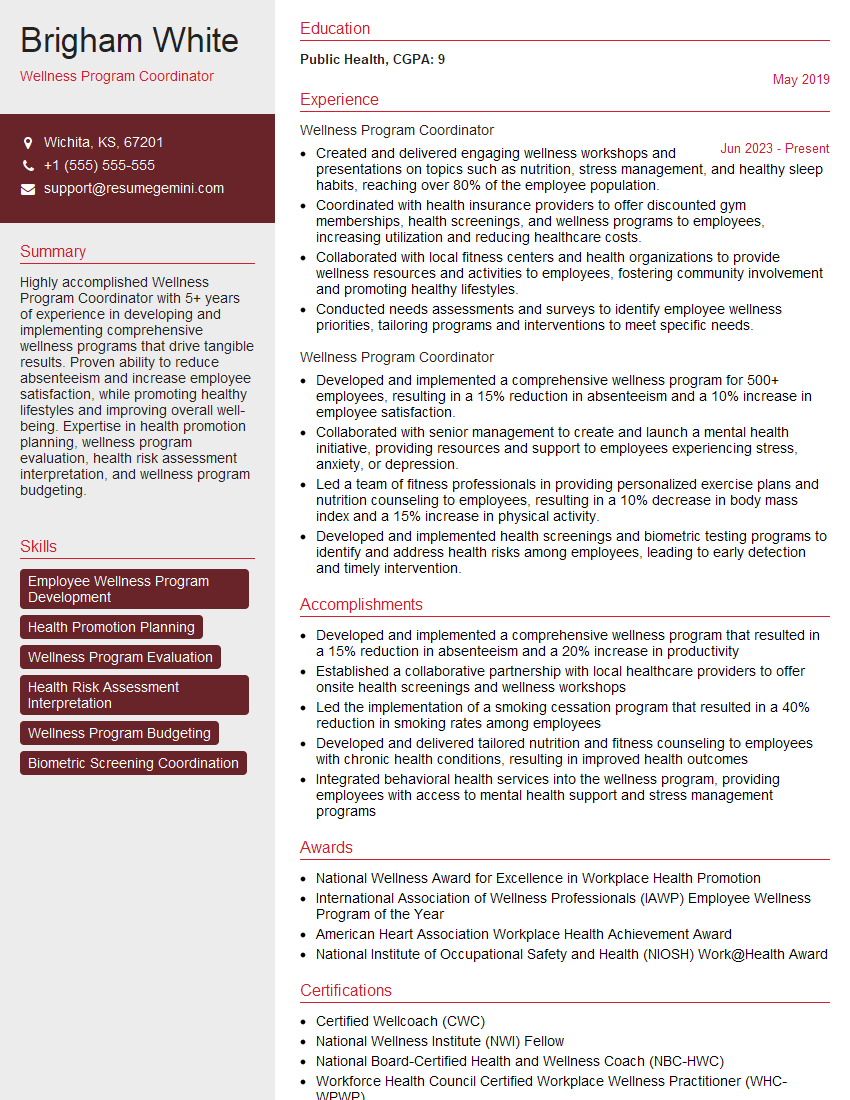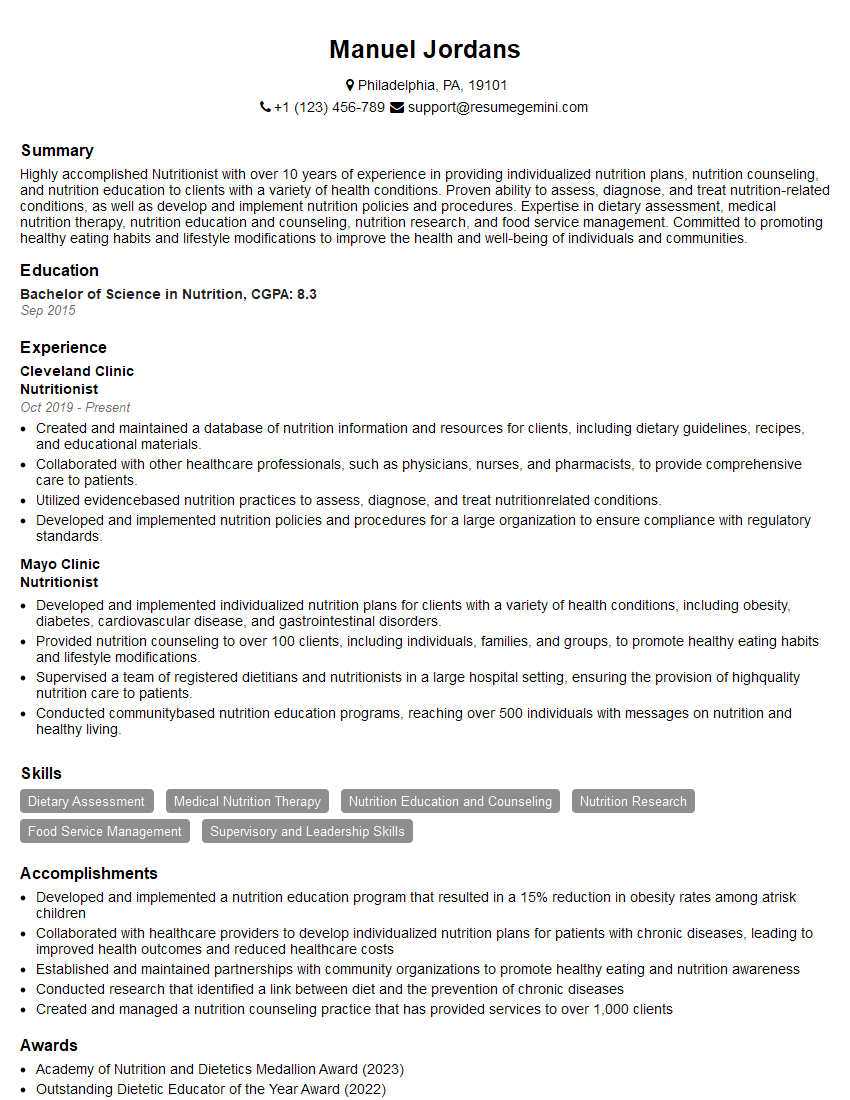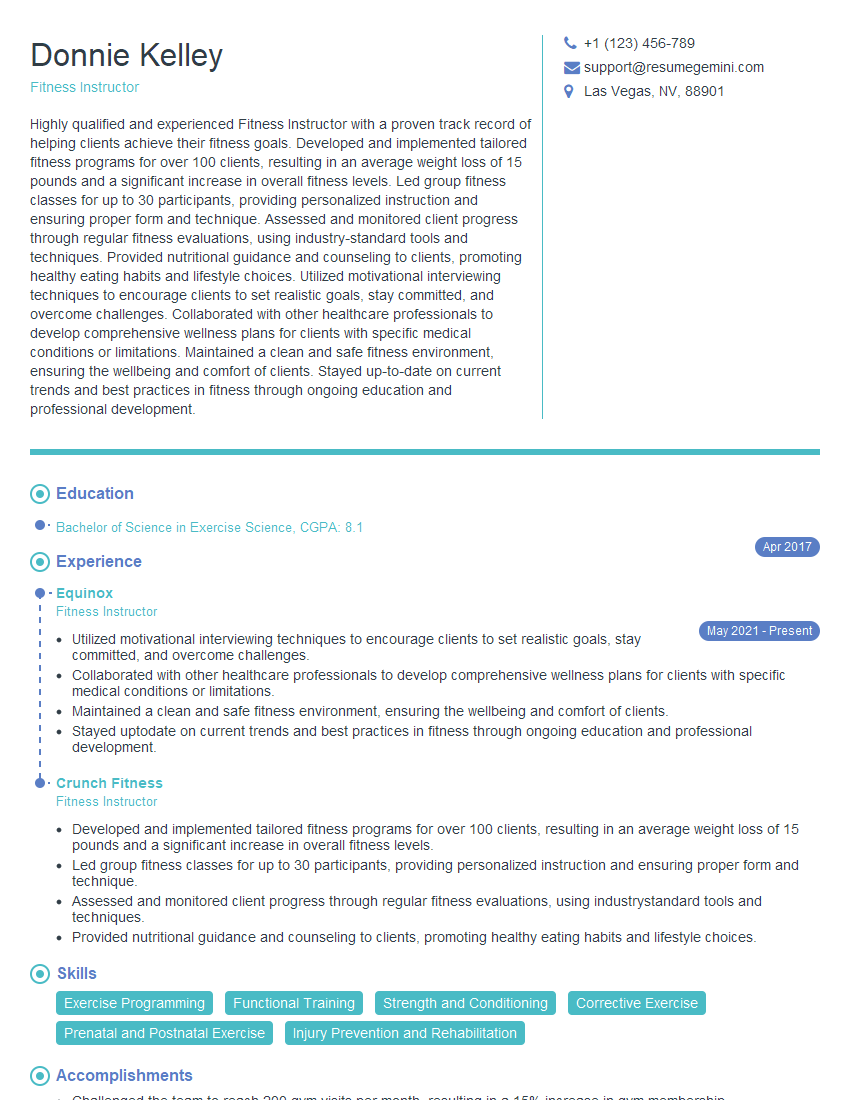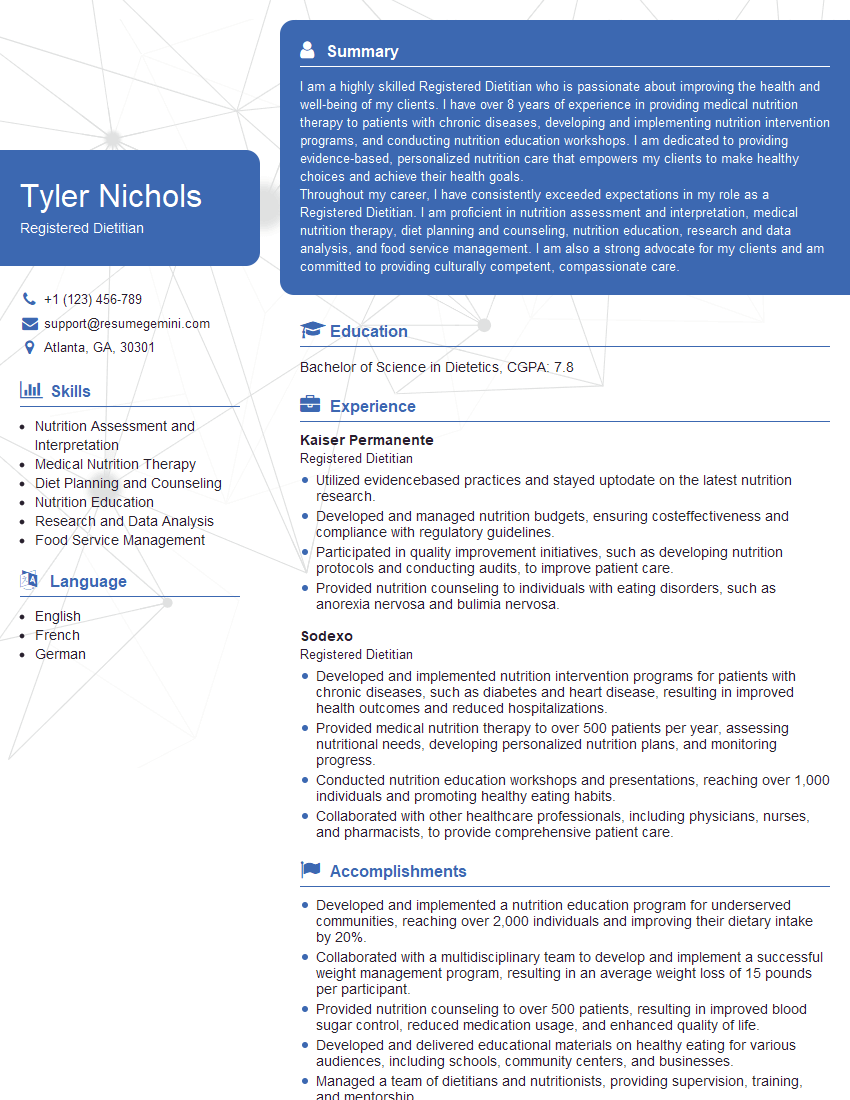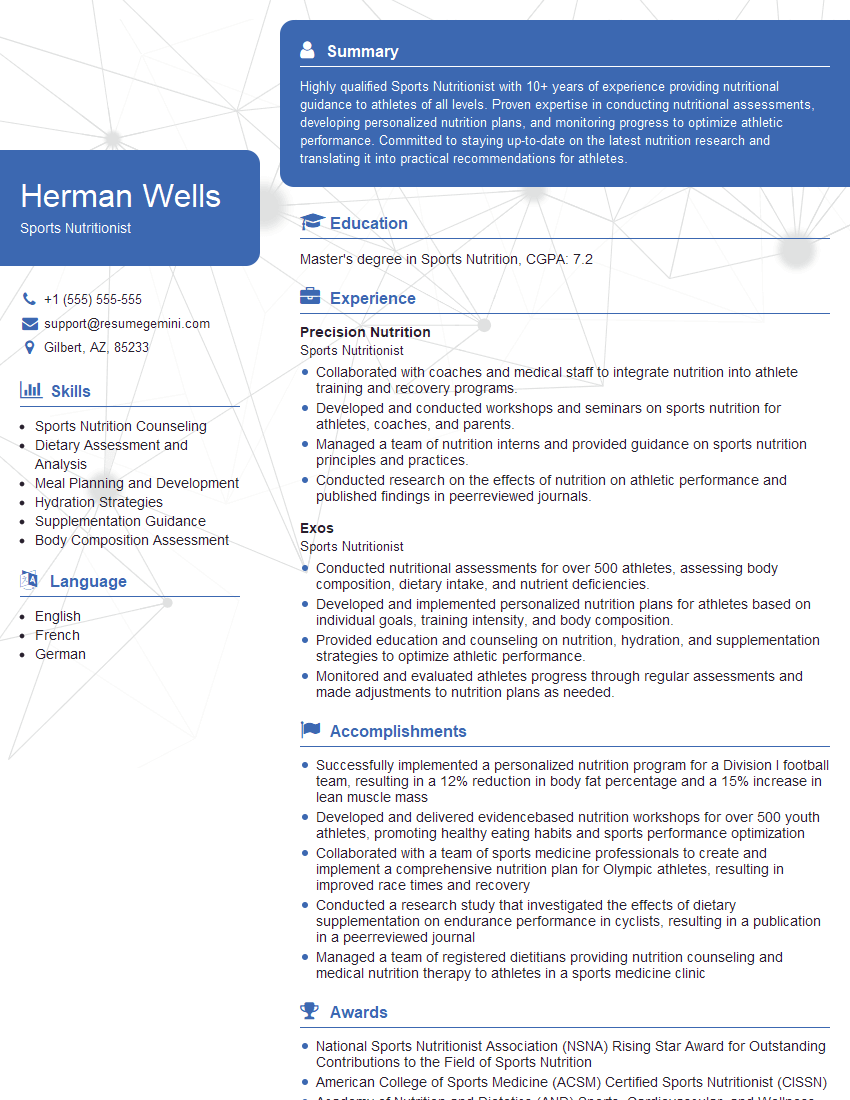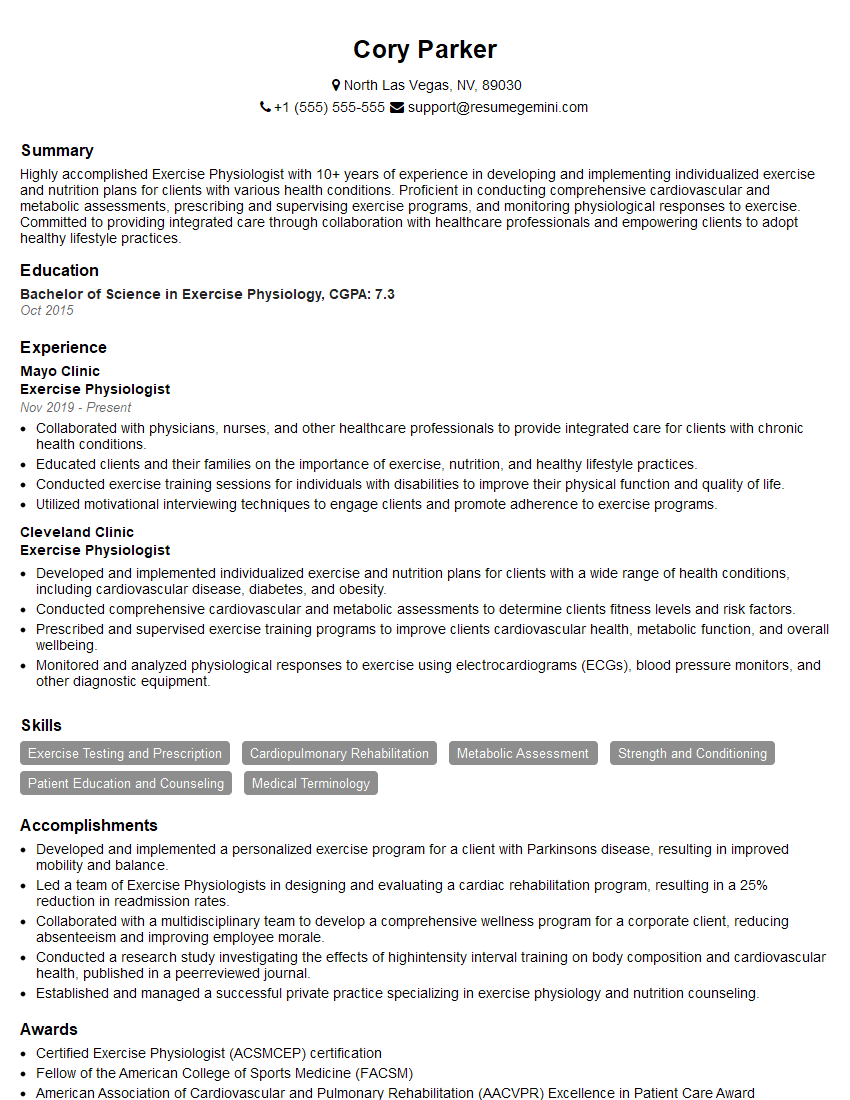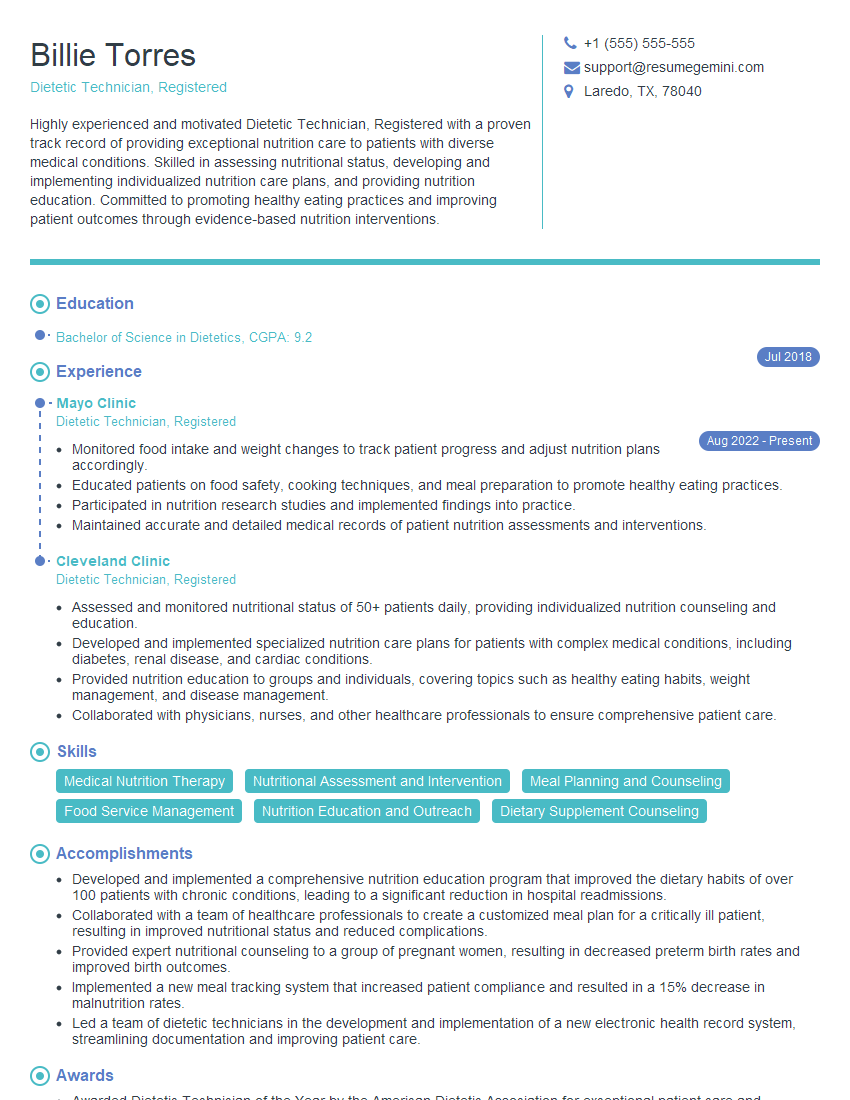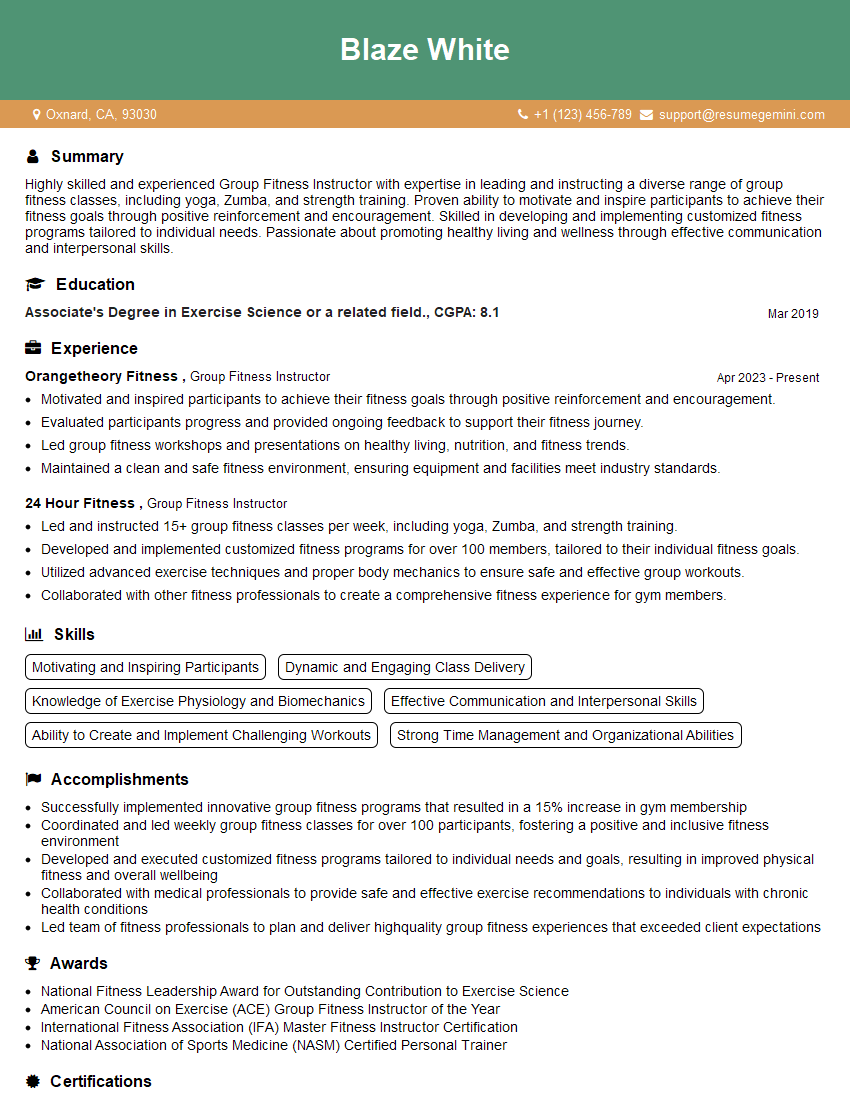Interviews are opportunities to demonstrate your expertise, and this guide is here to help you shine. Explore the essential Nutrition and fitness knowledge interview questions that employers frequently ask, paired with strategies for crafting responses that set you apart from the competition.
Questions Asked in Nutrition and fitness knowledge Interview
Q 1. Explain the difference between macronutrients and micronutrients.
Macronutrients and micronutrients are both essential for a healthy diet, but they differ significantly in their roles and quantities needed. Macronutrients are the energy-providing components of our food, required in relatively large amounts. These include carbohydrates, proteins, and fats. They provide the calories that fuel our bodies. Micronutrients, on the other hand, are vitamins and minerals required in smaller amounts, but are crucial for various bodily functions, acting as catalysts in metabolic processes and maintaining overall health. Think of it like this: macronutrients are the main course of your meal, providing the bulk of your energy, while micronutrients are the seasonings and spices, essential in smaller quantities to enhance the overall flavor (function) and health of the meal (body).
- Macronutrients: Provide energy (calories). Examples include grains, fruits, vegetables, meats, and oils.
- Micronutrients: Support bodily functions and metabolism; don’t provide significant energy. Examples include Vitamin C, Vitamin D, Calcium, Iron.
Q 2. Describe the role of protein in muscle growth and repair.
Protein plays a vital role in muscle growth and repair. It’s composed of amino acids, the building blocks of muscle tissue. When we engage in resistance training (like weightlifting), our muscle fibers experience microscopic tears. To repair these tears and build new muscle tissue, our body needs a sufficient supply of amino acids from the protein we consume. The process isn’t just about building bigger muscles; it’s about repairing and strengthening existing muscle fibers, improving strength, and enhancing overall muscle function. A sufficient protein intake ensures that the body has the necessary materials to efficiently complete the repair and growth process. Think of it like repairing a wall; you need bricks (amino acids from protein) to rebuild and reinforce the damaged areas.
Q 3. What are the key components of a balanced diet?
A balanced diet is crucial for overall health and well-being. It emphasizes a variety of nutrient-rich foods from all food groups. Key components include:
- Fruits and Vegetables: Rich in vitamins, minerals, fiber, and antioxidants.
- Whole Grains: Provide complex carbohydrates, fiber, and various nutrients. Choose whole wheat bread, brown rice, and oats over refined grains.
- Lean Protein: Essential for muscle growth and repair. Include sources like fish, poultry, beans, lentils, and tofu.
- Healthy Fats: Provide essential fatty acids crucial for brain health and hormone production. Include sources like avocados, nuts, seeds, and olive oil.
- Dairy or Dairy Alternatives: Provide calcium and vitamin D for bone health. Consider milk, yogurt, cheese, or plant-based alternatives like almond milk or soy milk.
The proportions of these food groups will vary based on individual factors like age, activity level, and health conditions. Consulting a registered dietitian can help you personalize your balanced diet plan.
Q 4. How do you calculate someone’s Basal Metabolic Rate (BMR)?
Basal Metabolic Rate (BMR) is the number of calories your body burns at rest to maintain basic bodily functions. There isn’t one single formula, but several equations are used to estimate BMR. These equations take into account factors such as age, sex, weight, and height. A commonly used equation is the Mifflin-St Jeor equation:
For men: BMR = (10 × weight in kg) + (6.25 × height in cm) - (5 × age in years) + 5For women: BMR = (10 × weight in kg) + (6.25 × height in cm) - (5 × age in years) - 161Where:
- Weight is in kilograms (kg).
- Height is in centimeters (cm).
- Age is in years.
It’s important to remember that these are estimations; individual BMR can vary. Online calculators are readily available, but consulting a healthcare professional for a personalized assessment is recommended, especially if you have specific health concerns.
Q 5. Explain the concept of energy balance.
Energy balance refers to the relationship between the amount of energy (calories) you consume and the amount of energy you expend. If you consume more calories than you burn, you’ll store the excess as fat, leading to weight gain. This is a positive energy balance. Conversely, if you burn more calories than you consume, you’ll lose weight, creating a negative energy balance. Maintaining a balanced energy balance, where calorie intake equals calorie expenditure, helps maintain a healthy weight. Think of it like a bank account: if your income (calories consumed) exceeds your expenses (calories burned), your balance (weight) increases. The goal is to achieve a balanced budget (energy balance) to maintain a healthy weight.
Q 6. What are the benefits and risks of low-carbohydrate diets?
Low-carbohydrate diets, such as ketogenic diets, restrict carbohydrate intake, forcing the body to use fat as its primary energy source.
Benefits: Some people experience significant weight loss initially. Others report improved blood sugar control, particularly for individuals with type 2 diabetes. Some studies suggest potential benefits in reducing seizures in certain neurological conditions.
Risks: Low-carbohydrate diets can lead to nutrient deficiencies if not planned properly. They can cause the so-called “keto flu” in the initial phase due to the body adapting to using fat for fuel, resulting in symptoms like headaches, fatigue, and nausea. Long-term adherence can lead to constipation due to low fiber intake, and potential kidney problems in susceptible individuals. Moreover, such diets are not sustainable for everyone, and there is a high rate of weight regain upon stopping the diet. It’s crucial to consult a healthcare professional or registered dietitian before embarking on a low-carbohydrate diet, especially if you have underlying health conditions.
Q 7. Discuss the importance of hydration for fitness.
Hydration is absolutely vital for optimal fitness performance. Water plays a critical role in many bodily functions, including:
- Temperature regulation: Water helps regulate body temperature during exercise, preventing overheating.
- Nutrient transport: Water transports nutrients to muscles and organs.
- Waste removal: It helps flush out waste products from the body.
- Joint lubrication: Water lubricates joints, reducing friction and preventing injury.
- Muscle function: Proper hydration is crucial for optimal muscle contractions.
Dehydration can significantly impair athletic performance, leading to fatigue, muscle cramps, and reduced endurance. Adequate hydration ensures that your body functions optimally during workouts and allows for quicker recovery afterward. Remember to drink water before, during, and after exercise to maintain optimal hydration levels.
Q 8. Describe different types of cardiovascular training.
Cardiovascular training, also known as cardio or aerobic exercise, strengthens your heart and lungs. There are many types, each offering unique benefits.
- Steady-State Cardio: This involves maintaining a consistent intensity level for a sustained period. Think of a jog at a comfortable pace for 30 minutes. It’s excellent for improving endurance and burning calories.
- Interval Training (HIIT): This alternates between high-intensity bursts and periods of rest or lower intensity. For example, sprinting for 30 seconds followed by 60 seconds of jogging, repeated several times. HIIT is very efficient for improving both cardiovascular fitness and strength.
- Circuit Training: This involves a series of exercises performed one after another with minimal rest. It combines cardio with strength training, offering a full-body workout. A sample circuit could include jumping jacks, push-ups, squats, and burpees.
- Cross-Training: This involves incorporating different types of cardio activities to prevent overuse injuries and maintain motivation. Switching between running, swimming, cycling, and elliptical training is a great example.
Choosing the right type of cardiovascular training depends on individual fitness levels, goals, and preferences. A well-rounded approach often involves a combination of these methods.
Q 9. Explain the principles of resistance training.
Resistance training, or strength training, involves using resistance to build muscle mass and strength. Several key principles guide effective programs:
- Progressive Overload: Gradually increasing the weight, reps, or sets over time to continually challenge your muscles. This is crucial for continued muscle growth.
- Specificity: Focusing on exercises that target specific muscle groups or movement patterns relevant to your goals. A bodybuilder will train differently than a marathon runner.
- Variation: Changing your workout routine regularly to prevent plateaus and promote overall fitness. This could involve altering exercises, sets, reps, or rest periods.
- Recovery: Allowing sufficient time for muscles to repair and rebuild after workouts. This includes adequate rest days and proper nutrition.
- Proper Form: Using correct technique to maximize results and minimize the risk of injury. It’s often better to lift less weight with perfect form than more weight with poor form.
Think of it like this: if you always lift the same weight for the same number of reps, your muscles will adapt and stop growing. Progressive overload ensures your muscles are continuously challenged, leading to greater strength and size.
Q 10. How do you assess a client’s fitness level?
Assessing a client’s fitness level is crucial for designing safe and effective exercise programs. This involves a combination of methods:
- Health History Questionnaire: Gathering information about medical conditions, medications, and past injuries.
- Resting Heart Rate and Blood Pressure: Measuring baseline cardiovascular health.
- Body Composition Analysis: Determining the proportion of fat mass to lean mass. Methods include skinfold calipers, bioelectrical impedance analysis (BIA), or underwater weighing.
- Cardiorespiratory Fitness Tests: Assessing the efficiency of the heart and lungs. Examples include the 1.5-mile run test or a graded exercise test (GXT).
- Muscular Strength and Endurance Tests: Evaluating strength and endurance through exercises like push-ups, sit-ups, and weight lifting assessments. This could involve 1RM (one-repetition maximum) testing.
- Flexibility Tests: Measuring range of motion in major joints. Examples include the sit-and-reach test.
Combining these assessments provides a comprehensive picture of the client’s fitness level, allowing for the creation of a personalized and safe training plan.
Q 11. What are the signs and symptoms of dehydration?
Dehydration occurs when your body loses more fluids than it takes in. Signs and symptoms can range from mild to severe:
- Mild Dehydration: Thirst, dry mouth, fatigue, headache, dizziness, decreased urine output (dark yellow urine).
- Moderate Dehydration: Sunken eyes, dry skin, low blood pressure, rapid heartbeat, muscle cramps.
- Severe Dehydration: Very rapid heartbeat, very low blood pressure, confusion, unconsciousness.
If you experience severe dehydration symptoms, seek immediate medical attention. Regular water intake throughout the day is crucial for preventing dehydration, especially during physical activity or hot weather.
Q 12. How do you adapt exercise programs for different age groups?
Adapting exercise programs for different age groups is crucial for safety and effectiveness. Considerations include:
- Children (under 12): Focus on fun, playful activities that develop fundamental movement skills. Avoid high-intensity training or specialized weight training. Emphasize proper technique and supervision.
- Adolescents (13-18): Progressive overload principles can be applied, gradually increasing intensity and resistance. Focus on building a foundation of strength and conditioning. Appropriate supervision and education on safe exercise practices are vital.
- Adults (19-64): Individualized programs should be designed based on fitness levels and goals. A variety of exercise modes, including cardio, strength training, and flexibility exercises, are recommended.
- Older Adults (65+): Exercise programs need to be tailored to account for age-related changes such as reduced bone density and joint mobility. Focus on maintaining balance, flexibility, and strength. Low-impact activities and modifications to exercises may be necessary.
Regardless of age, it’s essential to consult a healthcare professional before starting any new exercise program. Individual needs and limitations should always be considered.
Q 13. What is the role of fiber in the diet?
Fiber is a type of carbohydrate that the body can’t digest. It plays a vital role in maintaining good health:
- Digestive Health: Fiber adds bulk to stool, preventing constipation and promoting regular bowel movements. It also feeds beneficial gut bacteria.
- Blood Sugar Control: Soluble fiber slows down the absorption of sugar into the bloodstream, preventing blood sugar spikes and improving insulin sensitivity.
- Cholesterol Management: Soluble fiber binds to cholesterol in the digestive tract, helping to lower blood cholesterol levels.
- Weight Management: High-fiber foods are often more filling, promoting satiety and potentially aiding in weight loss.
Good sources of fiber include fruits, vegetables, whole grains, legumes, and nuts. Aim for a balanced intake of both soluble and insoluble fiber for optimal digestive and overall health.
Q 14. Explain the importance of pre and post-workout nutrition.
Proper pre and post-workout nutrition is crucial for optimizing performance and recovery.
- Pre-workout Nutrition (1-3 hours before): Focus on easily digestible carbohydrates for energy and a small amount of protein to prevent muscle breakdown. Examples include a banana with peanut butter or a small bowl of oatmeal.
- Post-workout Nutrition (within 30-60 minutes): This is the optimal time for replenishing glycogen stores and repairing muscle tissue. Consume a combination of carbohydrates and protein. Examples include a protein shake with fruit, a Greek yogurt with berries, or a turkey sandwich on whole-wheat bread.
The specific needs depend on the intensity and duration of the workout. For shorter, less intense workouts, the need for pre-workout nutrition might be less crucial. However, post-workout nutrition is always beneficial for muscle repair and recovery.
Q 15. How do you create a personalized nutrition plan?
Creating a personalized nutrition plan is a multi-step process that goes beyond simply recommending a diet. It requires a deep understanding of the individual’s needs, goals, and lifestyle. I begin with a thorough assessment, including a detailed dietary history, medical history (including any allergies or conditions), activity levels, and personal preferences. This initial consultation allows me to identify potential nutrient deficiencies, dietary restrictions, and any obstacles that might hinder their success.
Next, I determine their dietary needs based on factors like age, gender, activity level, and weight goals. For example, a highly active athlete will require a significantly different caloric and macronutrient intake than someone with a sedentary lifestyle. I consider their preferences to make the plan sustainable and enjoyable. Forcing someone to eat foods they dislike is a recipe for failure.
I then develop a plan that includes specific meal timing, portion sizes, and food choices aligned with their goals. This might involve increasing protein intake for muscle growth, reducing carbohydrates for weight loss, or adjusting fat intake to optimize overall health. The plan isn’t static; we regularly review progress and make adjustments based on their feedback and any changes in their circumstances. This iterative process ensures the plan remains effective and adaptable.
Finally, I provide ongoing support and guidance. This includes answering questions, troubleshooting challenges, and offering motivation. A personalized plan isn’t just about the food; it’s about building healthy habits and empowering the individual to take control of their nutrition.
Career Expert Tips:
- Ace those interviews! Prepare effectively by reviewing the Top 50 Most Common Interview Questions on ResumeGemini.
- Navigate your job search with confidence! Explore a wide range of Career Tips on ResumeGemini. Learn about common challenges and recommendations to overcome them.
- Craft the perfect resume! Master the Art of Resume Writing with ResumeGemini’s guide. Showcase your unique qualifications and achievements effectively.
- Don’t miss out on holiday savings! Build your dream resume with ResumeGemini’s ATS optimized templates.
Q 16. What are the common causes of nutritional deficiencies?
Nutritional deficiencies arise from an imbalance between the nutrients the body requires and the nutrients it receives. Several factors contribute to this imbalance:
- Insufficient dietary intake: This is the most common cause. Restrictive diets, poor food choices, or limited access to nutritious foods can lead to deficiencies in essential vitamins and minerals.
- Malabsorption: Certain medical conditions, such as Crohn’s disease or celiac disease, can impair the body’s ability to absorb nutrients from food, even if the diet is adequate.
- Increased nutrient requirements: Periods of rapid growth (e.g., pregnancy, childhood), illness, or intense physical activity can increase the body’s demand for specific nutrients, making it harder to meet needs through diet alone.
- Medication interactions: Some medications can interfere with nutrient absorption or metabolism, potentially leading to deficiencies.
- Alcohol abuse: Excessive alcohol consumption can interfere with nutrient absorption and increase the risk of deficiencies.
- Chronic diseases: Conditions like diabetes or kidney disease can affect nutrient metabolism and increase the risk of deficiencies.
For example, a vegan diet might lack sufficient vitamin B12 unless supplemented, while someone with celiac disease might struggle to absorb iron and other nutrients from gluten-containing foods. Identifying and addressing the underlying cause is crucial in treating nutritional deficiencies.
Q 17. Describe the different types of body composition assessments.
Body composition assessments measure the proportions of fat mass and fat-free mass (muscle, bone, water) in the body. Several methods exist, each with its strengths and limitations:
- Skinfold calipers: This involves measuring skinfold thickness at multiple sites using calipers. It’s a relatively inexpensive and portable method, but accuracy depends on the technician’s skill and can be affected by hydration levels.
- Bioelectrical impedance analysis (BIA): This method uses a small electrical current to estimate body fat percentage. It’s convenient and non-invasive, but accuracy can be affected by hydration levels, body temperature, and recent food intake.
- Hydrostatic weighing (underwater weighing): This gold-standard method measures body density by submerging the individual in water. It’s highly accurate but requires specialized equipment and can be uncomfortable for some.
- Air displacement plethysmography (Bod Pod): This method measures body volume using air displacement, providing a highly accurate assessment of body density and body composition. It’s more comfortable than hydrostatic weighing but still requires specialized equipment.
- DEXA (Dual-energy X-ray absorptiometry): This advanced imaging technique provides a detailed breakdown of body composition, including bone density. It’s highly accurate but expensive and uses ionizing radiation.
The choice of method depends on factors such as cost, availability, accuracy requirements, and client comfort. A combination of methods can provide a more comprehensive assessment.
Q 18. What is the importance of flexibility and mobility training?
Flexibility and mobility training are crucial for overall health and well-being. Flexibility refers to the range of motion at a joint, while mobility encompasses the ability to move efficiently and effectively through a range of motion. Both are essential for:
- Injury prevention: Improved flexibility and mobility reduce the risk of muscle strains, sprains, and other injuries by enhancing joint stability and reducing muscle tightness.
- Improved posture: Tight muscles can contribute to poor posture. Flexibility training helps to lengthen muscles and improve posture alignment, reducing pain and discomfort.
- Increased performance: Enhanced flexibility and mobility can improve athletic performance by allowing for a greater range of motion and more efficient movement patterns.
- Pain management: Flexibility and mobility exercises can help to alleviate pain associated with muscle stiffness, joint limitations, and other musculoskeletal conditions.
- Stress reduction: Flexibility exercises, such as yoga or Pilates, can help to reduce stress and improve mental well-being.
Examples of flexibility and mobility training include stretching (static, dynamic), yoga, Pilates, and foam rolling. A well-rounded fitness program should incorporate both types of training to optimize physical function and overall health.
Q 19. How do you address client concerns about weight management?
Addressing client concerns about weight management requires a sensitive and holistic approach. It’s crucial to avoid judgmental language and focus on fostering a positive and supportive environment. I start by understanding their concerns and goals, emphasizing that weight loss is a journey, not a race.
I assess their current diet and lifestyle, looking for areas for improvement. It’s not always about drastically cutting calories; sometimes, small, sustainable changes can make a big difference. For example, swapping sugary drinks for water, increasing vegetable intake, or incorporating more physical activity can lead to gradual weight loss.
I educate clients about healthy eating habits, portion control, and mindful eating. This includes explaining the importance of balanced meals, regular meal timing, and listening to their body’s hunger and fullness cues. I also address any misconceptions they may have about weight loss, such as crash dieting or fad diets. These are often unsustainable and can be detrimental to long-term health.
Furthermore, I help clients set realistic goals and track their progress. It’s essential to celebrate successes along the way and to address any setbacks constructively. Providing ongoing support and encouragement is vital for maintaining motivation and achieving long-term success. The focus should be on developing healthy habits that promote overall well-being, not just weight loss.
Q 20. Explain different types of cardiovascular exercises
Cardiovascular exercise, or cardio, improves heart health and overall fitness. Several types exist, each offering unique benefits:
- Aerobic exercise: This involves sustained, rhythmic activity that elevates the heart rate and breathing for an extended period. Examples include running, swimming, cycling, and brisk walking.
- High-intensity interval training (HIIT): This involves alternating between short bursts of intense exercise and periods of rest or low-intensity activity. It’s a time-efficient way to improve cardiovascular fitness and burn calories.
- Low-impact cardio: This is gentler on the joints and suitable for individuals with injuries or limitations. Examples include swimming, cycling, elliptical training, and walking.
- Water aerobics: This type of exercise takes place in water, reducing the impact on joints while providing a good cardiovascular workout.
- Dance: Various dance styles provide an enjoyable and effective way to improve cardiovascular fitness and coordination.
The best type of cardiovascular exercise depends on individual preferences, fitness levels, and any physical limitations. A balanced approach, incorporating a variety of cardio activities, is recommended for optimal results and to prevent boredom.
Q 21. How do you motivate clients to maintain healthy habits?
Motivating clients to maintain healthy habits requires a multi-pronged approach that goes beyond simply providing information. I focus on building a strong client-professional relationship based on trust and mutual respect. This involves active listening, understanding their individual challenges, and tailoring my approach to meet their specific needs.
I encourage clients to set realistic, achievable goals that are personally meaningful to them. These goals shouldn’t be solely focused on weight loss but should encompass broader aspects of well-being, such as increased energy levels, improved mood, or better sleep. Breaking down larger goals into smaller, manageable steps helps to build momentum and prevent feelings of overwhelm.
I utilize behavior change techniques, such as self-monitoring, goal setting, and reward systems. Self-monitoring, through tracking food intake, exercise, or sleep patterns, can help to raise awareness of behaviors and identify areas for improvement. Reward systems, such as celebrating milestones or enjoying a non-food reward, can provide positive reinforcement and motivation.
Finally, I foster a sense of community and support. This might involve connecting clients with support groups, providing regular check-ins, and offering ongoing encouragement and guidance. Maintaining healthy habits is a long-term commitment, and having a support system can make all the difference in staying motivated and achieving sustainable success.
Q 22. Describe your approach to designing a strength training program.
Designing a strength training program requires a holistic approach, considering the individual’s goals, experience level, and any physical limitations. It’s not a one-size-fits-all solution. My approach involves several key steps:
- Needs Assessment: I begin with a thorough consultation to understand the client’s fitness goals (e.g., muscle gain, strength improvement, weight loss), training history, and any injuries or health conditions. This helps me tailor a program that’s both effective and safe.
- Program Design: Based on the assessment, I design a program that incorporates a balanced mix of compound exercises (targeting multiple muscle groups simultaneously, like squats, deadlifts, bench presses) and isolation exercises (focusing on individual muscles, like bicep curls, triceps extensions). The program will progressively overload the muscles, gradually increasing the weight, reps, or sets over time to stimulate growth and strength gains.
- Progressive Overload: This principle is crucial. We gradually increase the demands placed on the muscles to continue stimulating growth. This could involve increasing weight, reps, sets, or changing the exercises themselves. We track progress to ensure we’re appropriately challenging the client without causing overtraining.
- Proper Form and Technique: Correct form is paramount to prevent injuries. I meticulously teach clients the proper techniques for each exercise, often demonstrating and correcting their movements throughout each session. Videos and mirrors are used to support learning and provide feedback.
- Rest and Recovery: Adequate rest is crucial for muscle repair and growth. The program will incorporate rest days, allowing sufficient time for recovery between workouts. The frequency of training depends on the individual’s goals and recovery capacity. Overtraining can lead to injury and hinder progress.
- Periodization: To prevent plateaus, we employ periodization, which involves systematically varying training variables like volume, intensity, and rest periods over time. This ensures consistent progress and prevents the body from adapting to the same routine.
- Monitoring and Adjustment: Regular check-ins and progress evaluations are vital. We adjust the program based on the client’s response, making modifications as needed to ensure optimal results and address any challenges or setbacks.
For example, a beginner might start with a full-body workout 2-3 times a week, focusing on lighter weights and higher repetitions, gradually increasing the intensity and volume over several weeks or months. An experienced lifter might follow a more advanced program, incorporating different training splits (e.g., upper/lower body splits, push/pull/legs splits) with heavier weights and lower repetitions.
Q 23. What are the benefits of incorporating HIIT into workout routines?
High-Intensity Interval Training (HIIT) involves short bursts of intense exercise followed by brief recovery periods. Its benefits are numerous:
- Improved Cardiovascular Fitness: HIIT significantly improves cardiovascular health by increasing heart rate and oxygen consumption. It’s highly efficient in boosting VO2 max (the maximum amount of oxygen your body can utilize during exercise).
- Enhanced Fat Burning: HIIT workouts lead to significant calorie expenditure during and after the workout (EPOC – Excess Post-exercise Oxygen Consumption). This elevated metabolism contributes to increased fat burning even after the session is over.
- Increased Metabolic Rate: HIIT workouts stimulate the metabolism, leading to a higher resting metabolic rate, meaning you burn more calories even when at rest.
- Time Efficiency: A typical HIIT workout can be completed in 20-30 minutes, making it ideal for individuals with busy schedules.
- Improved Insulin Sensitivity: Studies have shown HIIT can improve insulin sensitivity, which is beneficial for individuals with or at risk of developing type 2 diabetes.
Example: A typical HIIT workout could involve sprinting for 30 seconds at maximum effort followed by 60 seconds of rest or low-intensity jogging. This cycle is repeated for 8-12 rounds. It’s important to tailor the intensity and duration of the intervals based on the individual’s fitness level to avoid injury and ensure proper recovery.
Q 24. How do you address injuries that may occur during training?
Injury prevention and management are paramount. My approach emphasizes proactive strategies:
- Proper Warm-up and Cool-down: I always emphasize the importance of dynamic warm-ups before each workout to prepare the muscles and joints for exercise and static stretching afterwards for muscle recovery and flexibility.
- Correct Exercise Technique: Correct form is crucial. I provide individualized instruction and feedback to ensure clients maintain proper technique throughout each exercise, minimizing the risk of injury.
- Gradual Progression: I advocate for a gradual increase in training intensity and volume to allow the body to adapt progressively, avoiding sudden increases that could lead to injury.
- Rest and Recovery: Sufficient rest is essential for muscle repair and injury prevention. I encourage clients to prioritize sleep and listen to their bodies, taking rest days when needed.
- Addressing Injuries: If an injury occurs, I recommend immediate cessation of the activity and rest. Depending on the severity, I advise seeking professional medical advice (physician or physiotherapist) for diagnosis and treatment. Once cleared, we may gradually reintroduce exercise with modifications as needed. This often involves working with the client’s physical therapist to develop a rehabilitation plan that allows for safe return to training.
For example, if a client experiences knee pain during squats, we might modify the exercise by reducing the weight, adjusting the stance, or substituting with an alternative exercise like leg press. I always prioritize client safety and well-being above all else.
Q 25. How do you educate clients about portion control?
Educating clients about portion control is crucial for achieving and maintaining a healthy weight. My approach is multifaceted:
- Visual Aids: Using visual aids like hand sizes or measuring cups can help clients understand appropriate portion sizes for different food groups. For example, a serving of meat is about the size of a deck of cards.
- Plate Method: The plate method is a simple visual guide: half the plate should be filled with non-starchy vegetables, a quarter with lean protein, and a quarter with complex carbohydrates.
- Mindful Eating Techniques: I teach clients to pay attention to their hunger and fullness cues, eating slowly and savoring their food. This helps them recognize when they’re truly satisfied, preventing overeating.
- Food Journaling: Keeping a food journal allows clients to track their food intake, identify patterns, and become more aware of their eating habits. This can be particularly useful in identifying areas for improvement.
- Understanding Caloric Needs: I help clients understand their individual caloric needs based on their age, gender, activity level, and weight goals. This helps them make informed choices about portion sizes to support their weight management goals.
I avoid restrictive diets and focus on building healthy eating habits that can be sustained long-term. For example, instead of telling a client to avoid all sweets, I might encourage them to enjoy treats in moderation and choose healthier options.
Q 26. Explain the role of sleep in recovery and overall health.
Sleep plays a vital role in recovery and overall health. During sleep, the body repairs and rebuilds tissues, including muscles damaged during exercise. Insufficient sleep impairs this process, leading to reduced performance, increased injury risk, and impaired immune function.
- Muscle Repair and Growth: Growth hormone, crucial for muscle repair and growth, is primarily released during sleep. Lack of sleep hinders this process, hindering gains from strength training.
- Hormonal Balance: Sleep deprivation disrupts hormonal balance, impacting appetite regulation (leading to increased cravings and weight gain) and stress management (increasing cortisol levels).
- Cognitive Function: Adequate sleep is essential for cognitive function, including concentration, memory, and decision-making. This impacts both training performance and adherence to a fitness and nutrition plan.
- Immune Function: Sleep is crucial for immune function. Chronic sleep deprivation weakens the immune system, making individuals more susceptible to illness.
- Mood Regulation: Sufficient sleep contributes to improved mood and reduces stress, which is crucial for both physical and mental well-being. Stress can impair recovery and lead to overtraining.
Aim for 7-9 hours of quality sleep per night. Establish a consistent sleep schedule, create a relaxing bedtime routine, and optimize your sleep environment for darkness, quiet, and a comfortable temperature to ensure adequate restorative sleep.
Q 27. What are the common misconceptions regarding diet and exercise?
Many misconceptions surround diet and exercise. Some common ones include:
- ‘No Pain, No Gain’: While pushing oneself is important, pain should not be tolerated. Pain is a signal that something is wrong and should be addressed. Discomfort is expected, but pain is a sign to stop.
- ‘Spot Reduction’: It is impossible to target fat loss in specific areas of the body. Weight loss occurs throughout the body, not just in specific areas. Targeted exercises can build muscle in specific regions but won’t necessarily burn fat in those same areas.
- ‘Cardio is the Only Way to Lose Weight’: While cardio is beneficial for overall health and weight loss, it’s not the sole method. Strength training is equally important for building muscle mass, increasing metabolism, and improving body composition.
- ‘All Calories Are Created Equal’: The caloric content of food is important, but the quality of calories matters too. 100 calories from processed foods have different effects on the body compared to 100 calories from whole, unprocessed foods.
- ‘Skipping Meals Boosts Metabolism’: Skipping meals often leads to overeating later and can disrupt metabolic function. Regular, balanced meals support a healthy metabolism.
- ‘Detox Teas or Cleanses Are Necessary’: The body has its own detoxification system; there’s no need for special products or diets to eliminate toxins.
It’s important to base fitness and nutrition plans on evidence-based information rather than myths and misconceptions.
Q 28. How do you stay up to date on the latest research in nutrition and fitness?
Staying current in nutrition and fitness requires a commitment to continuous learning. My strategies include:
- Peer-Reviewed Journals: I regularly read peer-reviewed journals like the Journal of the American College of Nutrition, Medicine & Science in Sports & Exercise, and The American Journal of Clinical Nutrition to stay updated on the latest research findings.
- Professional Organizations: I’m an active member of professional organizations like the Academy of Nutrition and Dietetics and the American College of Sports Medicine. These provide access to continuing education opportunities, conferences, and networking with other professionals in the field.
- Conferences and Workshops: Attending conferences and workshops allows me to learn about the latest advancements and network with experts in the field.
- Reputable Online Resources: I utilize reputable online resources, such as government health websites (e.g., NIH, CDC) and professional organization websites, to access reliable information and guidelines.
- Continuing Education: I actively participate in continuing education courses to maintain my certifications and expand my knowledge base.
By constantly seeking new information and critically evaluating research findings, I can ensure that my advice and practices remain up-to-date and evidence-based.
Key Topics to Learn for Nutrition and Fitness Knowledge Interview
- Macronutrient Balance: Understanding the roles of carbohydrates, proteins, and fats in diet and exercise performance. Practical application: Designing meal plans to meet specific energy and nutrient needs.
- Micronutrient Importance: The crucial roles of vitamins and minerals in overall health and athletic performance. Practical application: Identifying nutrient deficiencies and recommending appropriate dietary interventions.
- Dietary Guidelines and Recommendations: Familiarity with established guidelines (e.g., MyPlate) and their application to diverse populations and health conditions. Practical application: Counseling clients on healthy eating habits based on individual needs.
- Exercise Physiology: Understanding the physiological responses to exercise, including metabolic adaptations and training principles. Practical application: Designing personalized exercise programs considering client fitness levels and goals.
- Exercise Programming and Prescription: Developing safe and effective exercise programs for various populations and fitness levels. Practical application: Assessing client needs and designing tailored workout routines.
- Weight Management Strategies: Understanding the principles of energy balance and developing strategies for healthy weight loss or gain. Practical application: Guiding clients through safe and sustainable weight management approaches.
- Nutritional Assessment: Methods for assessing nutritional status, including dietary intake analysis and anthropometric measurements. Practical application: Interpreting assessment data to identify nutritional needs and risks.
- Client Communication and Counseling: Effective communication techniques for providing nutrition and fitness guidance. Practical application: Motivating and supporting clients in achieving their health and fitness goals.
- Supplementation Strategies: Understanding the appropriate use of nutritional supplements in athletic performance and health. Practical application: Evaluating the benefits and risks of various supplements.
Next Steps
Mastering nutrition and fitness knowledge is crucial for career advancement in this dynamic field. A strong understanding of these concepts will significantly enhance your interview performance and open doors to exciting opportunities. To maximize your job prospects, it’s vital to create an ATS-friendly resume that effectively showcases your skills and experience. ResumeGemini is a trusted resource to help you build a professional and impactful resume. We provide examples of resumes tailored to nutrition and fitness knowledge to guide you through the process. Invest time in crafting a compelling resume – it’s your first impression on potential employers.
Explore more articles
Users Rating of Our Blogs
Share Your Experience
We value your feedback! Please rate our content and share your thoughts (optional).
What Readers Say About Our Blog
Hello,
We found issues with your domain’s email setup that may be sending your messages to spam or blocking them completely. InboxShield Mini shows you how to fix it in minutes — no tech skills required.
Scan your domain now for details: https://inboxshield-mini.com/
— Adam @ InboxShield Mini
Reply STOP to unsubscribe
Hi, are you owner of interviewgemini.com? What if I told you I could help you find extra time in your schedule, reconnect with leads you didn’t even realize you missed, and bring in more “I want to work with you” conversations, without increasing your ad spend or hiring a full-time employee?
All with a flexible, budget-friendly service that could easily pay for itself. Sounds good?
Would it be nice to jump on a quick 10-minute call so I can show you exactly how we make this work?
Best,
Hapei
Marketing Director
Hey, I know you’re the owner of interviewgemini.com. I’ll be quick.
Fundraising for your business is tough and time-consuming. We make it easier by guaranteeing two private investor meetings each month, for six months. No demos, no pitch events – just direct introductions to active investors matched to your startup.
If youR17;re raising, this could help you build real momentum. Want me to send more info?
Hi, I represent an SEO company that specialises in getting you AI citations and higher rankings on Google. I’d like to offer you a 100% free SEO audit for your website. Would you be interested?
Hi, I represent an SEO company that specialises in getting you AI citations and higher rankings on Google. I’d like to offer you a 100% free SEO audit for your website. Would you be interested?
good
